32+ ways to celebrate historic preservation during National Historic Preservation Month
(These days I am pretty busy and spend hours each day commuting to and from Baltimore County so I am not writing much, plus, I am focusing more and more and more on transportation planning, so I forgot about National Historic Preservation Month. For the most part, this post is reprinted from last year, but there are a number of additions so it's worth re-reading.)
1. Become a member of the DC Preservation League, which focuses on citywide preservation issues.
2. Join a neighborhood preservation group (such as Capitol Hill Restoration Society, Historic Takoma, or Historic Mount Pleasant).
3. Join the National Trust for Historic Preservation while you're at it. If you join, you can visit NT owned sites and affiliate organization museums at a discount/free, get discounts at Historic Hotels, and discounts on products you purchase.
4. Volunteer. Get involved in a preservation issue in your neighborhood or the city at large, which could include attending meetings of the Historic Preservation Review Board, or joining a Main Street commercial district revitalization group in your neighborhood.
As one example, in the Takoma DC/Takoma Park neighborhood in DC, one of the neighborhood preservation issues is trying to get control of the Takoma Theatre, and reopening it as an arts facility. The owner is recalcitrant and wants to either sell it for more than it is worth as a theater, or to tear it down and build apartments-condominiums, but of course, today's real estate market doesn't make the latter choice economic, not to mention, not possible because the building, fortunately, is a protected resource in the DC Inventory of Historic Sites. Join the Takoma Theatre Conservancy and work with others to make the dream become reality.
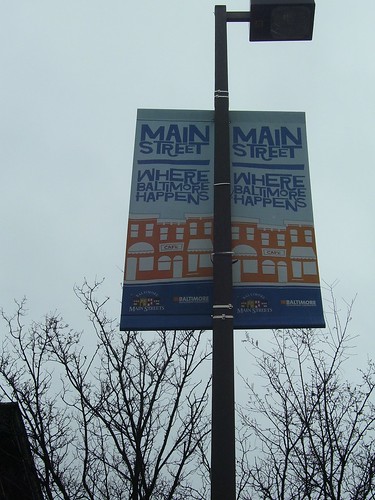
5. See a movie or play at a historic theater. There aren't many historic cinemas in DC proper any more, but the Uptown Theater in Cleveland Park is one. (Help the Takoma Theatre Conservancy get ownership of the Takoma Theatre. It's one of the only examples of a relatively intact neighborhood cinema still existing in the city.)
For "legitimate" theaters you have many choices, such as the Warner, the National, the Studio Theatre, the Lincoln Theatre, the Shakespeare Theatre at the Landsburgh, the Atlas Performing Arts Center, the H Street Playhouse, and sort of kind of the Tivoli Theatre in Columbia Heights.

6. Shop at stores in commercial districts that are historically designated: i.e., Cleveland Park; Georgetown; Capitol Hill; Dupont Circle.
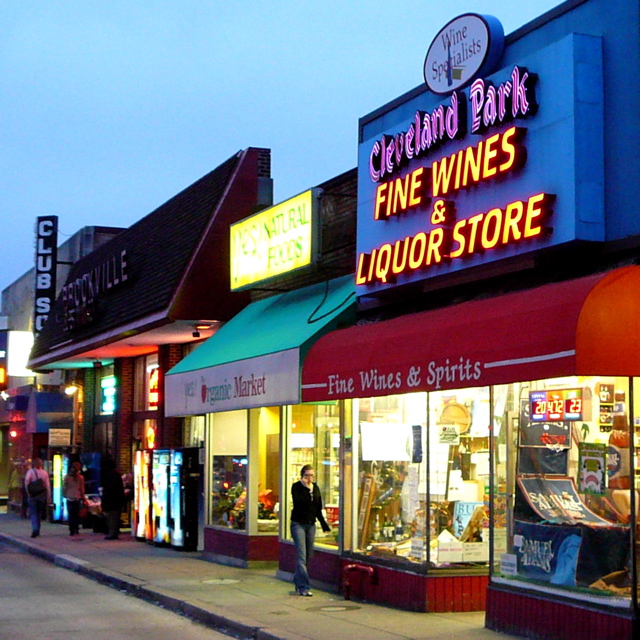
Flickr photo by M.V. Jantzen, who writes, Cleveland Park has some of the best neighborhood-serving retail shops. 3423 Connecticut Ave NW, Washington, DC.
7. Eat in a restaurant in a historic building/historic district. It's not that old, only 50 years, but Ben's Chili Bowl is one of the few remaining restaurants in the city that is truly old... Two years ago, Reid suggested Martin's Tavern in Georgetown, and Will suggested Cafe Mozart, a German restaurant downtown.
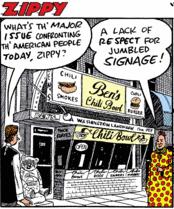
8. Explore a place in the city that you don't know. Go on a neighborhood tour, such as those sponsored by Cultural Tourism DC or neighborhood groups, a house tour, or building tour. Check out a talk (not all of them cost money) at the National Building Museum.
Many groups sponsor house tours. Last Sunday's was the tour in Takoma. This weekend, there is the house tour in Capitol Hill. At the end of the month (May 21st and 22nd) there are tours all around the city as part of WalkingTownDC.

9. Shop at a historic public market. Eastern Market, the city's last remaining public food market building, built in 1873, will be reopening in July probably. There is also the Florida Market district, not as fancy, or the Maine Avenue Seafood Market.
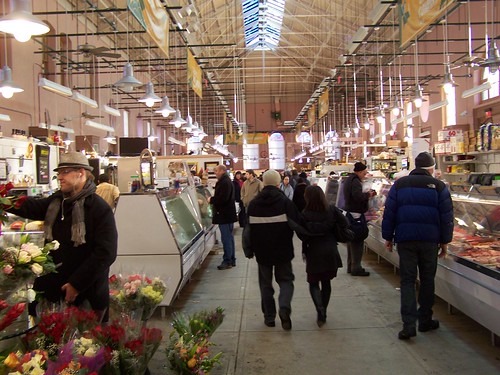
Eastern Market
10. Check out the resources at the Washingtoniana Collection at the Martin Luther King Central Library, the Kiplinger Library at the Historical Society of Washington, the Jewish Historical Society.
11. Learn. Read Dream City: Race, Power, and the Decline of Washington, D.C., 1964 -1994 and Between Justice and Beauty, and more...
12. Such as going to a conference such as Preservation Maryland, the annual meeting of the National Trust for Historic Preservation (this year it's in Austin, Texas in late October), the National Main Street conference, and when you visit other places, check out how they deal with historic preservation matters, and offer that learning to us when you come back.
Preservation Maryland has a good conference. This year it's in Easton, Maryland, on May 20th and 21st.
13. Read at least one of the historic district brochures, available online or in hard copy at the Historic Preservation Office.
14. And follow the path of one of the many Heritage Trails "produced" by CulturalTourismDC.

15. Take a walk or bicycle ride along the C&O Canal. (And I suppose it's allowable to drive along a national, state, or local scenic byway.)
16. Visit one of the historic cemeteries in the city, such as Congressional Cemetery or the Rock Creek Church Cemetery at St. Paul's Episcopal Church.
17. Explore historic preservation matters in the region, beyond the borders of DC. Go to the Bladensburg Waterfront Park in Bladensburg, Maryland and consider the time when this was a major port, when tobacco was king, and DC was still part of Prince George's County, Maryland. They offer river rides on the weekends, including a jaunt into DC to the National Arboretum.
The Historic Hyattsville (Maryland) house tour is Sunday May 16th.
Silver Spring has launched a historic trail. It will be constructed over time, but they have 6 markers in place now, and the didactics on the signs are excellent. If you like Vietnamese food, one of the markers is just a couple doors down from a Vietnamese restaurant, across the street from the B&O Railroad Station, at the southeast corner of Georgia Avenue and Sligo Avenue.
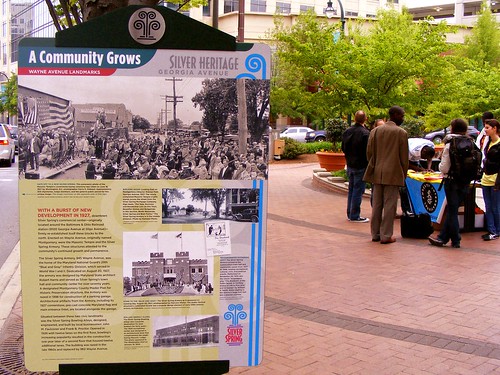
Flickr photo of the Wayne Avenue marker by thecourtyard.
At the Riversdale Mansion in Riverdale, Maryland, the Quarterly Lecture is on Tuesday May 18th at 7:30 pm, and features Donald Shomette, underwater archaeologist, as he presents his lecture "New Perspectives on the Battle of Bladensburg." (fee)
(2014 is the 200th anniversary of the sacking of Washington, the Battle of Bladensburg, and the writing of the Star Spangled Banner, so Maryland in particular is working up many events in commemoration. DC has just started doing some planning as well, but Maryland has been working on this for at least 3 years.)
Fee: $5; Student, $2.50
18. Check out an exhibit at the Anacostia Community Museum or the Historical Society of Washington or one of the other house museums and historic sites in the city and region.
19. Check out the architecture of a historic church, especially the stained glass windows. (St. Mark's on Capitol Hill has a Tiffany stained glass window. My friend Daniel Wolkoff repairs and restores stained glass windows, including spectacular windows at Catholic University
20. Encourage your friends to stay at a historic hotel in the city or a bed and breakfast located in one of the city's historic districts. Now, I don't think Tabard Inn is in a historic district, but it's one of the most romantic places in the city to have weekend brunch--out on the patio, during the spring, summer, and fall.

Brunch at Tabard Inn, Flickr photo by lilpixiegirl03.
21. Walk on the grounds of one of the universities (CUA, Trinity, Georgetown, Howard, Gallaudet). E.g., Kendall Green at Gallaudet was designed by Frederick Law Olmsted.

Historic photo (Library of Congress) of Kendall Green, Gallaudet University.
22. Visit Union Station. Designed by Daniel Burnham, it's an incredible example of the City Beautiful Movement. Check out chapters from Bill Wright's dissertation on Union Station. He's a great writer!

23. At the National Museum of American History, go see the exhibit on transportation history, "America on the Move." Part of it uses Washington as an example specifically. But in any case, it explains the role of transportation in urban and regional development, and will give you a lot of insight into these issues as they relate to the DC region.

24. Ride Amtrak, MARC, or VRE along rail lines in the region. And check out the B&O Railroad Museum (Baltimore), the Baltimore Streetcar Museum and the National Capital Trolley Museum (Montgomery County, Maryland).
25. Visit one of the Fort Circle Parks in the city, sites of Civil War forts erected to protect the city from the Confederates. Fort Stevens, hidden behind a church on Georgia Avenue, around Quackenbos Street NW, was attacked by Confederate forces, and President Lincoln was up there and watched.
26. Learn about the L'Enfant Plan and the McMillan Commission, so that you can understand the antecedents of the city, and make better land use decisions going forward, for your neighborhood and for the city. Start with Washington in Maps by Iris Miller and Washington: Through Two Centuries by Joseph Passonneau. And see "Washington: Symbol and City," a permanent exhibit at the National Building Museum.

27. Relatedly, on May 19th, there is an all-day symposium at the National Building Museum, "Power, Architecture, and Politics: The Design of Washington and the U.S. Commission of Fine Arts," which will look at the issue of "monumental" Washington, the federal government, and the federal commission, the CFA, which oversees and guides the federal interest. (Gillette's book, Between Justice and Beauty, covers this issue in terms of the federal versus local interests.)
It's free, but you need to register.
28. Visit the Lincoln Cottage on the grounds of the Armed Forces Retirement Home. Or the Octagon House, or the Scottish Rite Temple on 16th Street, or ...?
29. The DC Public School system has an archives and museum that is also a meeting center, Sumner School, at 17th and M Streets NW.
30. A number of DC's libraries were built with support from the Carnegie Foundation (Northeast, Southeast, the old Carnegie Library downtown, Takoma, and Mount Pleasant, which is particularly gorgeous). Visit one. (Arguably, the beauty of the Mount Pleasant Library is being wrecked by a now underway expansion project. We'll see.)

31. Take a boat trip on the Anacostia River. I believe that the pontoon boat tours from the Bladensburg Waterfront Park (in Prince George's County) dip into DC. From their website:
Free interpretive pontoon boat tours take place from April through October.
32. If you own "an old house," and want to learn more, I highly recommend subscribing to magazines such as Old House Journal, Old House Interiors, American Bungalow, This Old House, etc., for many reasons. You learn about historic architecture and details. They run features on interesting neighborhoods, places you can try to see when you travel. And the magazines offer good ideas of how to make historically appropriate changes in your own house.
I had never been interested much in "the decorative arts" and interiors of houses all that much before, but having moved into a 1929 bungalow that was relatively intact, and including a 1930s Magic Chef Oven, I've become much more attuned and interested.
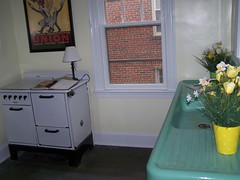
This photo is from when we saw the house the first day. Obviously, you don't put lamps on your oven. The image shows the oven to the left, and a side view of the double sideboard seamfoam green kitchen sink, which dates from the early 1920s.
33. What suggestions do you have?
Labels: civic engagement, cultural heritage/tourism, historic preservation, local history



1 Comments:
Much thanks to you for giving such significant data, and a debt of gratitude is for sharing this Business Promotion system.
Post a Comment
<< Home